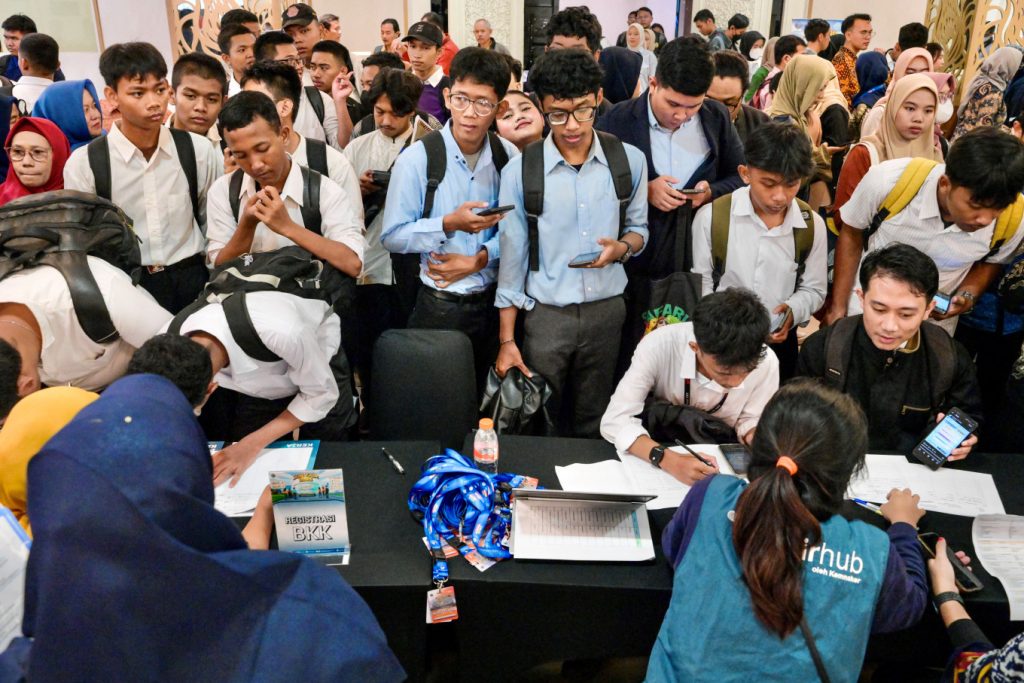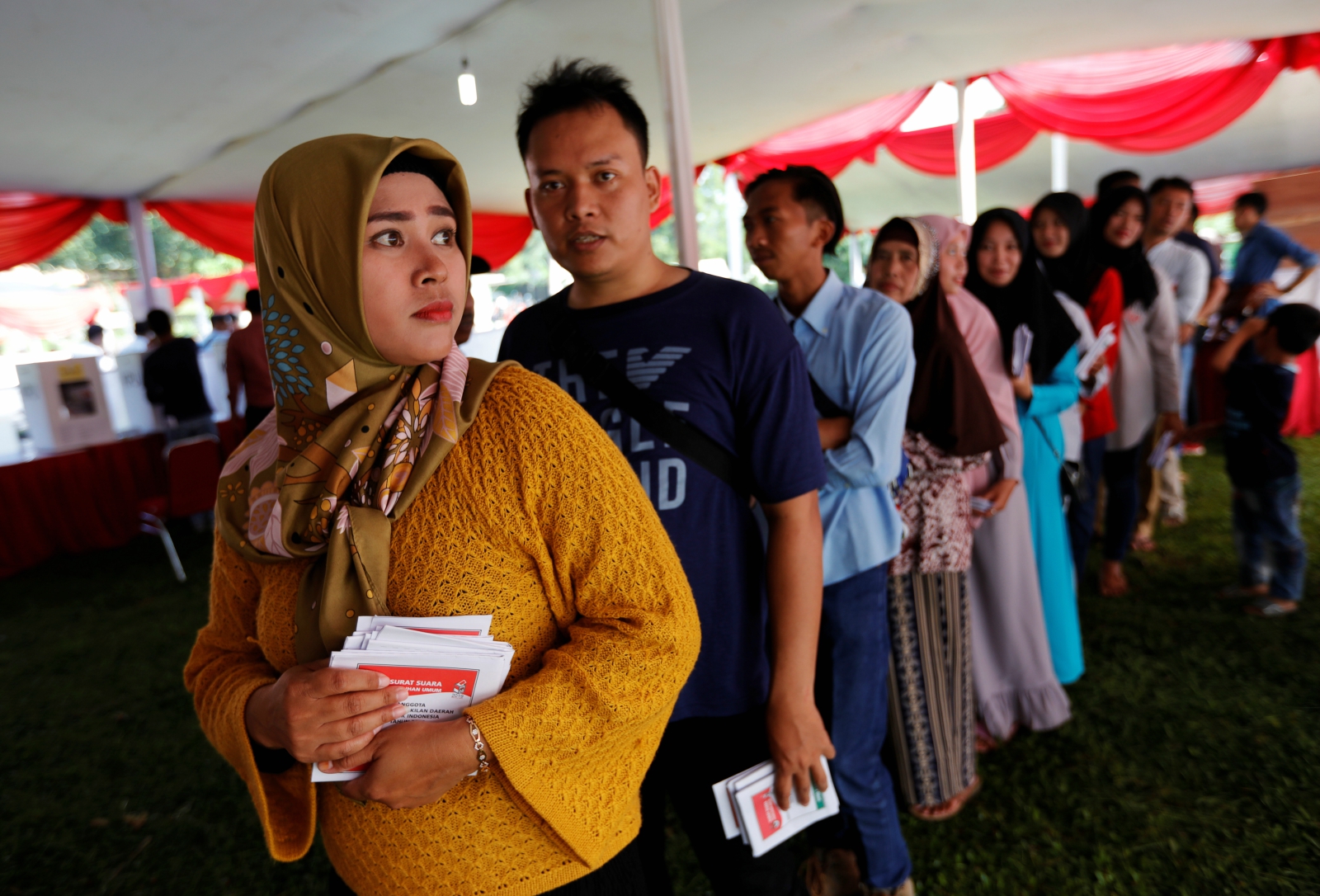Too many Indonesian young people remain undertrained and underutilized for an economy striving for higher productivity.

Job seekers register themselves during a job fair attended by over a hundred recruiting companies and thousands of job seekers in Jakarta on May 22. (AFP/Bay Ismoyo)
Early in his term, President Prabowo Subianto‘s administration is facing the harsh economic realities impacting many Indonesians. In the first quarter of this year alone, over 24,000 people lost their jobs. Many who attended job fairs left empty-handed, as vacancies were filled quickly or available roles did not match their skills. Even the gig economy, once a safety net for millions, including ojol (app-based ride-hailing motorcycle taxi) drivers, is no longer as promising.
Beneath these immediate labor woes lies a more profound concern. According to Statistics Indonesia (BPS) 2020 census data, an estimated 40-45 percent of Millennials and Gen Z, who will make up nearly two-thirds of the electorate by 2029, have not completed high school. Without deliberate reforms and sustained investment, the ambitious Golden Indonesia Vision 2045 risks becoming a distant mirage.
A concerted, nationwide lifelong learning strategy is urgently needed. This is not about fragmented policies addressing immediate problems but a systemic approach that bridges current gaps with future aspirations.
Standing on the promise of Asta Cita, Prabowo is charting a bold course marked by tighter political, administrative, and fiscal centralization. His administration aims to streamline governance and renew focus on nationwide development, as reflected in the unfolding Mid-term National Development Plan (RPJMN) 2025–2029.
However, beneath this coherent top-down blueprint lies a widening gulf, particularly between the more educated, connected, and urban populations and the larger mass of Indonesia’s rural and peri-urban youth. Too many of these young people remain undertrained and underutilized for an economy striving for higher productivity. This divide is not abstract, most live outside main economic centers and have exited formal schooling without ever entering the modern economy.
While the RPJMN acknowledges the importance of human capital and vocational training, it misses a crucial element: A nationwide, sustained, and locally driven system of lifelong learning. This is not just an educational shortfall, it is a structural fault line.
Without credible and accessible pathways back into learning and training, this group risks being sidelined both economically and developmentally. This risk is compounded by Indonesia’s continuously evolving central-regional governance.
With governors, regents, and mayors increasingly accountable to political leaders in Jakarta, coupled with recent legislation limiting local budget flexibility and more complex delineations of authority, the room for local innovation and initiatives is constrained. Even well-meaning local leaders struggle to program or fund tailored skills programs, village-level re-skilling, or training support.
Indonesia already possesses a national framework that could anchor a lifelong learning system: The Kejar Paket A, B, and C non-formal education programs. These community-based platforms, especially Paket C (the high school equivalency program), are run by private learning and teaching centers (PKBM) across regencies and mayoralties. In their current form, however, they remain disconnected from the labor market and are often perceived as inferior to formal schooling. Worse, the RPJMN barely addresses their transformative potential.
What if Kejar Paket C was reimagined not just as a second-chance education program but as a dual-credentialing platform? Existing work-training programs in public vocational training centers (BLKs), organized under manpower governance functions, could be coupled with Kejar Paket C for skills training. This integration could include certified vocational skills, digital literacy, or entrepreneurship training alongside academic equivalency.
Since these generational cohorts may already be seeking livelihoods and raising families, an incentive structure, such as a conditional cash transfer program like Program Keluarga Harapan (PKH), could provide tuition or compensatory wage support for attending courses. A high school diploma combined with an accredited, portable, and industry-linked skill would be a game-changer for youth in regions like Jambi, Jayapura, Jombang, or Jeneponto.
In decentralization reform and national development initiatives, the promise of empowered local governments to respond to their communities’ realities has been evident. For instance, province-wide innovations in East Java, pairing non-formal education with vocational training, have effectively matched skills with market demands, significantly reducing youth unemployment compared to generic national programs. However, such local ingenuity is becoming the exception rather than the norm.
Reforming Kejar Paket C requires resolving a quiet governance problem. While formal senior high schools and vocational schools are controlled by provincial authorities, non-formal education remains the responsibility of sub-provincial governments. Many of these lack the fiscal discretion, technical support, or political cover to innovate or initiate such undertakings. Left unaddressed, this fragmentation will continue to stunt the program’s effectiveness and reach.
Village-level institutions are also underutilized. Village fund regulations permit spending on digitalization, community empowerment, and youth resilience, yet few villages translate this into structured skills training. With the right incentives, village governments are eager to support local agro-processing, creative industries, or hospitality training tied to tourism, but they often wait for direction, models, or metrics from above.
The stakes could not be higher. The promise of Golden Indonesia 2045 hinges on making the demographic dividend productive. Without real learning pathways, the least-educated youth will remain trapped in low-wage survival cycles, reliant on subsidies, and vulnerable to predatory schemes like pinjol (online borrowing) or judol (online gambling). Meanwhile, the more educated, especially in urban centers, will grow restless and disillusioned by slow growth and exclusion from decision-making.
This growing polarity, if unchecked, could trigger social fragmentation and economic stagnation.
The time for inaction has passed. Lifelong learning must be repositioned at the heart of Indonesia’s human capital strategy. This begins by reforming Kejar Paket C into a credible dual-track platform, with funding, standards, and incentives aligned with provincial labor markets and supported by both public and private sectors.
Above all, education must be reframed, not as something that ends at graduation, but as a lifelong national infrastructure, no less critical than roads, ports, or fiber optic cables. The vision for Golden Indonesia 2045 remains within reach, but only by widening the circle of those able to contribute.
We cannot craft a golden future but leave millions behind. While feeding young Indonesians may win votes, teaching and equipping them to build their own livelihoods will secure the future.
The window to act is narrow, but with political resolve and strategic reform, it remains open.*
Adi Abidin is a public policy specialist at Kiroyan Partners, with a long-standing focus on decentralization reform since the 2000s. The views expressed are personal.
Source: The Jakarta Post, June 25, 2025.
Download the clipping here.



